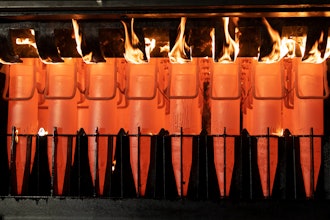
Federal investigators say BNSF railroad is analyzing a section of fractured rail after last month's fiery derailment that prompted evacuations in southwest Minnesota, but they didn't say definitively that the broken rail caused the crash.
The National Transportation Safety Board issued its preliminary report Tuesday on the March 30 derailment that forced about 800 people from their homes in Raymond, Minnesota, after 10 ethanol cars derailed and several of them caught fire from the fuel additive leak. Those ethanol cars were among 23 cars that came off the tracks shortly before 1 a.m. that day.
The fire burned into the following day before firefighters could extinguish it, but no one was hurt and everyone who evacuated was able to return home within 12 hours of the derailment. Investigators estimated that the derailment caused $1.9 million of damage to railroad equipment and the tracks.
This Minnesota derailment only added to the growing concerns about railroad safety in the wake of the fiery Feb. 3 Norfolk Southern derailment outside East Palestine, Ohio. Roughly half the town of about 5,000 had to evacuate in the days after that derailment, when hazardous chemicals were released and burned, leaving many residents with questions about the potential for long-term health problems.
People who live around the derailment that happened near the Pennsylvania border are demanding more answers as the railroad works to clean up contaminated soil and water. Norfolk Southern's CEO testified in Ohio's legislature Tuesday after previously appearing at two Congressional hearings focused on possible railroad safety reforms.
The NTSB said that two of the ethanol cars were punctured during the Minnesota derailment even though they were the upgraded models of tank cars that were designed to resist leaks after a string of fiery crude oil and ethanol derailments a decade ago. The fire from those leaking ethanol cars damaged the gaskets on three other ethanol cars nearby, causing them to leak as well, even though the gaskets were rated to withstand temperatures up to 225 degrees Fahrenheit (107.2 degrees Celsius).
The Forth Worth, Texas-based railroad declined to comment on the NTSB investigation, but spokesperson Amy McBeth said the cleanup at the site is largely complete. She said testing in the area hasn't shown any threat to human health or the environment.
At the time of the derailment, state officials said they weren't especially concerned about groundwater contamination because most of the ethanol would burn off and the ground remained frozen, with temperatures hovering just a few degrees above zero Fahrenheit (-17.78 degree Celsius).
Investigators said that at the time of the derailment, the train was going 43 mph — which is below the 49 mph speed limit for the area.
The Minnesota derailment happened about 100 miles (161 kilometers) west of Minneapolis. The full NTSB report on the derailment, which will identify the cause, may take more than a year to complete.
The crew of the 40-car train included an engineer, a conductor, a brakeman and a conductor trainee. None of them were hurt.






















